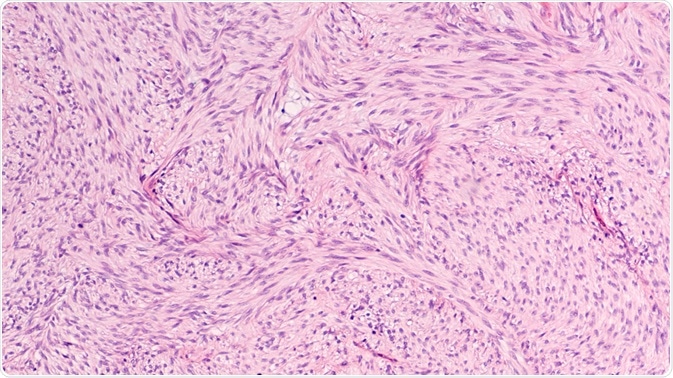Stroma is the region of an organ or tissue that has a connective or structural role and is also comprised of all of the constituents that do not have a specific function within the organ, such as blood vessels, connective tissue, ducts, and nerves.

Image Credit: David A. Litman/Shutterstock.com
The opposite of the stroma is known as the parenchyma, which consists of all of the cells that perform the primary function of that specific organ or tissue.
Connective tissues can be found within the stroma, with this essential tissue belonging to a group called: connective tissue proper.
The main function of this connective tissue proper is to fully secure the parenchymal tissue into place, which includes the nerves and blood vessels, to spread mechanical tension as to reduce any localized physical stress, and to bind the organs together. The stromal tissue mainly consists of an extracellular matrix that contains cells of connective tissue.
Have there been many studies on the stroma?
Many previous studies have shown consistently that carcinomas (a type of cancer) are closely associated with a highly reactive stromal environment. Reactive stroma typically not only initiates itself early during the progression of cancer, but also co-evolves alongside cancer, and additionally represents a native host response to disturbed homeostasis of the epithelial cells.
As a whole, this reactive stromal response is mostly generic and serves as a repair function. The tenacity of this initial cellular response is what is regularly observed in certain fibrosis disorders, as well as during the progression of specific cancers.
What is significantly less obvious, however, are the specific types of cells and their initial origins, as well as how the biochemistry of this reactive stroma affects tumor progression.
Most of the previous studies surrounding this concept have repeatedly shown that reactive stromal environments typically promote tumorigenesis, and yet the specific mechanisms behind this are still not fully understood.
The impact of cells by the stromal compartment during cancer growth is significantly complex, involving a balance between tumorigenesis-promoting and tumor-inhibition processes. Still, the idea of targeting the newly reactive stroma inside the tumor’s microenvironment as a method of inhibiting the progression of cancer is a promising one.
The significance of cancer-associated stroma to the progression and initiation of different cancers is currently well accepted in the medical community. Nonetheless, as changes in the stroma of benign occurring tumors are currently poorly understood, it remains unclear as to how cancer-associated stroma from both malignant and benign tumors compare to each other.
There have been many studies that observe how cancerous stroma can be adjusted to dampen or completely remove the negative effects of growing and metastasizing cancers.
How is stromal reprogramming used?
Every year approximately 135,000 people in Europe and the United States of America are diagnosed with a form of pancreatic ductal adenocarcinoma, otherwise known as the most common type of pancreatic cancer.
Patients with this disease typically have a 1-year survival rate of approximately 20%, with the 5-year survival rate decreasing dramatically to just 7%. In most cases of this form of cancer, a surgical procedure is not typically possible, with chemotherapy and radiotherapy, therefore, being the commonly offered treatment. Nonetheless, these current treatment options are still not particularly effective, usually resulting in additional survival of approximately 2-5 months.
One of the main reasons that these treatments tend not to work is that the abundant desmoplastic reactions that occur in patients with pancreatic ductal adenocarcinoma, also known as the tumor stroma, which is known to support cancer metastasis, invasion, and progression.
New therapies for the treatment of this cancer type have an aim to break-up (or modulate) the tissue components of the stroma within the tumor(s). A selection of scientific studies performed under a variety of circumstances has all consistently portrayed a tumor-reducing effect, by separating the stroma.
Therefore, it has recently been suggested to reduce or stop stromal activity in tumors to observe therapeutic benefits in these patients.
In conclusion, these studies were able to consistently demonstrate that using the stroma within tumors can be advantageous when considering cancer therapies, as it is safer and potentially more effective than the current methods of cancer treatment, especially for an inoperable tumor or aggressive cancer types.
In the future, more human trials could ultimately lead to the regular use of stromal reprogramming as an efficient and economical method of treating notoriously dangerous cancer types.
Sources
Schnittert J. et al. (2018). Reprogramming tumor stroma using an endogenous lipid lipoxin A4 to treat pancreatic cancer. https://doi.org/10.1016/j.canlet.2018.01.072
Rowley D.R. (2014) Reprogramming the Tumor Stroma: A New Paradigm. https://doi.org/10.1016/j.ccell.2014.09.016
Amini P. et al. (2019). Differential stromal reprogramming in benign and malignant naturally occurring canine mammary tumors identifies disease-promoting stromal components. https://doi.org/10.1101/783621
Further Reading
Last Updated: Feb 3, 2020